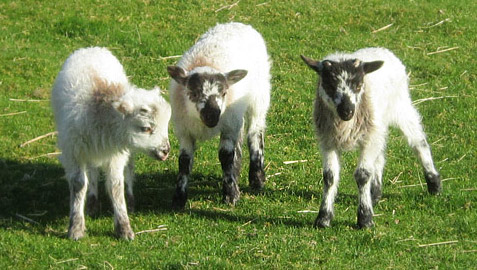St Kilda, the home of the Boreray
Boreray is an uninhabited island in the St Kilda archipelago which lies some 41 miles to the north west of Benbecula in the Outer Hebrides, and 110 miles from the Scottish mainland. The archipelago consists of four small islands (the remains of an extinct volcano) that contain the highest cliffs in the UK: Hirta, the largest, Dun, Soay and the most remote, Boreray, which lies four miles to the north east of the other islands. There is evidence that all the islands have been inhabited at some time in the past; Hirta was possibly inhabited for over a thousand years until it was evacuated in 1930.
Boreray – approximately 189 acres – has been called ‘The Fortress’ and has two rock stacks nearby, Stac an Armin and Stac Lee. These three islands are home to thousands of seabirds, notably gannets, fulmars and puffins. Boreray is only accessible in a few places in very calm seas and then only by jumping on to rocks or by swimming! It is then a very steep climb to the higher levels where there is grass – and Boreray sheep.
The St Kildans, who lived on Hirta, led a very frugal existence, their diet consisting mainly of seabirds and their eggs. There is little evidence of fish in their diet and lamb/mutton only rarely, despite being surrounded by sea and keeping flocks of sheep. Men from St Kilda would visit Boreray to collect birds’ eggs and sheep’s wool as well as the occasional sheep in times of particular hardship. The sheep that they chose to take back from Boreray were apparently thrown into the sea and picked up by other men in boats. The wool was used to make tweed and this, along with oil from the sea birds was a means of paying their rent to the owner of the islands, the laird, and to purchase meagre additional provisions.
The islanders leave
The population of Hirta was never high and the early twentieth century saw more and more St Kildans moving to the mainland and elsewhere to seek a better way of life. This exodus, along with a high infant mortality rate, food shortages and illness, plus an aging population saw the numbers dwindle to 36 in 1930. The decision was made to evacuate the island. But what of the sheep? The sheep from Hirta went with the islanders to their new homes although some were slaughtered. In 1932 the Soay sheep were moved from Soay Island to Hirta.
But the Borerays were left on their island. Presumably it was difficult enough to evacuate the islanders along with their sheep, without tackling the difficult voyage over to Boreray Island and its mountainous terrain to take off a few Boreray sheep. So they remained as a feral flock until 1971 when the Animal Breeding Research Organisation (ABRO) based in Edinburgh, decided to investigate the quality of the wool of the Boreray breed. A small number of sheep – seven in total – were taken off the island and in due course new breeding flocks were established on the Scottish mainland.
In the years since then, small flocks have been set up throughout the UK where various intrepid owners have got to know this tough, independent breed. They were initially called ‘Hebridean Blackface from Boreray’ but this soon became shortened to ‘the Boreray’, as they were now different to the Hebridean in many ways. There is no genetic connection between the Soay and Boreray breeds.



